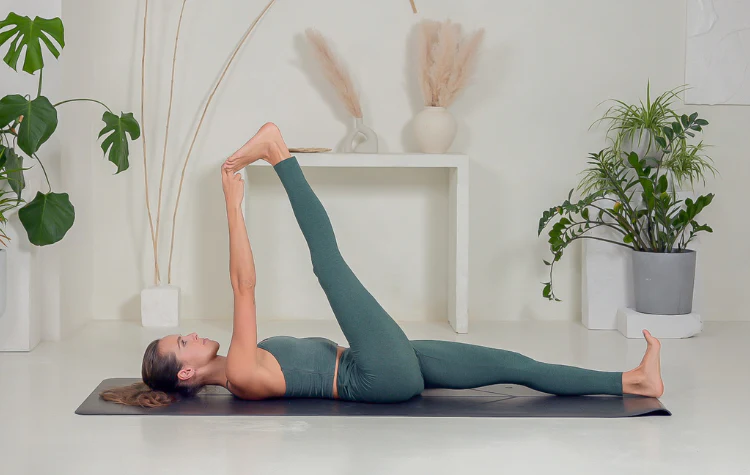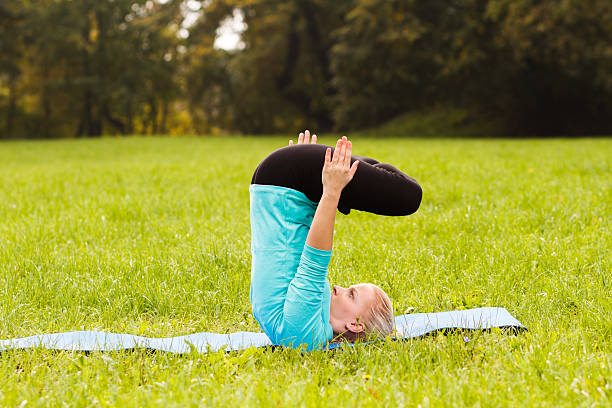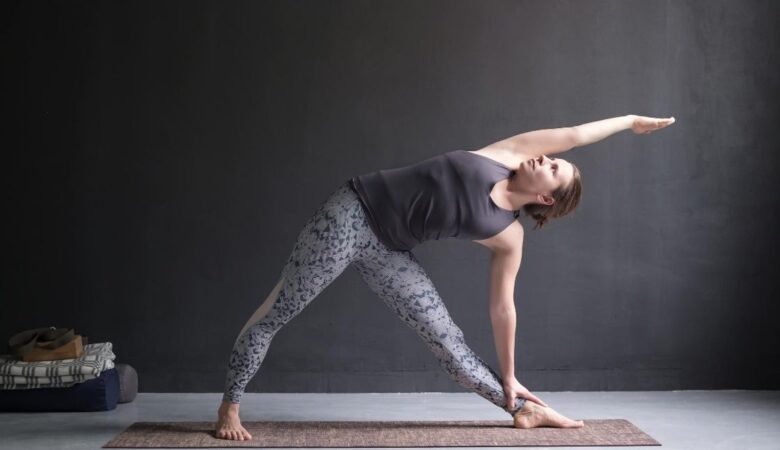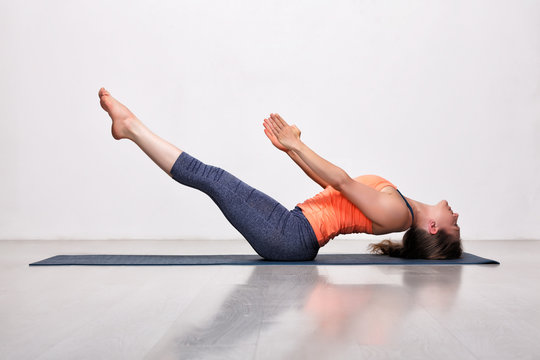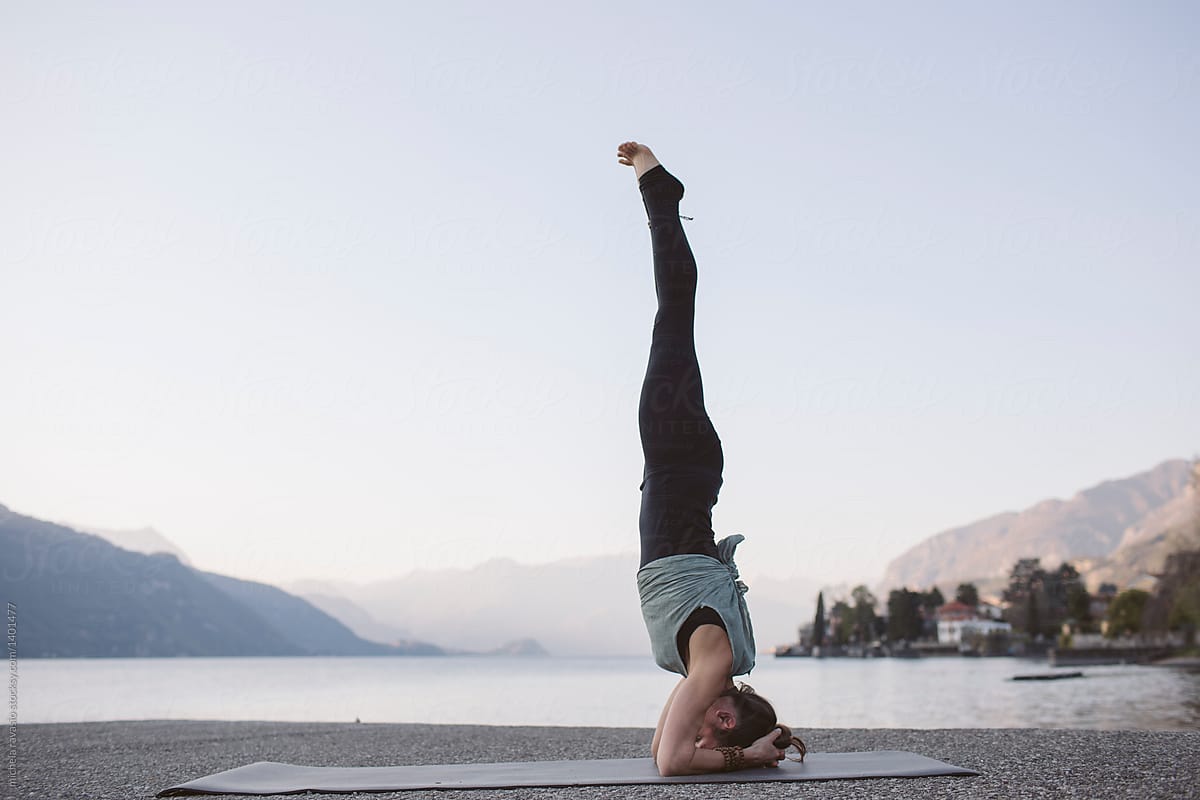Supta Padangusthasana, also known as the “Reclining Hand-to-Big-Toe Pose,” is a restorative and deeply stretching yoga asana that enhances flexibility, strengthens muscles, and improves posture. This pose offers a variety of benefits for both the body and mind, making it a popular choice in both beginner and advanced yoga practices. In this article, we’ll delve into the benefits, variations, step-by-step instructions, common mistakes, and frequently asked questions related to Supta Padangusthasana.
Table of Contents
What is Supta Padangusthasana?
The name “Supta Padangusthasana” comes from the Sanskrit:
- Supta – Reclining
- Pada – Foot
- Angusta – Big Toe
- Asana – Pose or Posture
In Supta Padangusthasana, “supta” refers to the reclining position, and the practitioner stretches one leg at a time while holding the big toe with the hand. It’s a powerful pose to deepen flexibility in the hamstrings, calves, and lower back, as well as to strengthen the core and hip flexors gently.
This pose is commonly performed at the end of a yoga practice or during a restorative flow. It can also be used as a preparatory pose for more advanced postures, like Forward Fold (Paschimottanasana) or seated stretches.
Step-by-Step Instructions for Supta Padangusthasana:
Here’s how to practice Supta Padangusthasana correctly:
Start in a Reclining Position:
Begin by lying flat on your back on a yoga mat. Extend your legs and relax your arms by your sides with palms facing up.
Engage Your Core:
Press your lower back into the mat to activate your core. This will help stabilize the pelvis during the pose.
Lift One Leg:
Slowly raise your right leg toward the ceiling, keeping it straight. Try to keep your knee fully extended, and engage your quadriceps to straighten the leg.
Hold the Big Toe:
Reach for your right big toe with your right hand, using a yoga strap around the foot if you’re unable to reach it with your hand. The strap should be looped around the ball of your foot, and your hand should be holding the strap.
Adjust the Leg:
Once you have a hold of your toe or strap, extend the leg to a 90-degree angle or beyond (as far as your flexibility allows). Your left leg should remain straight on the floor, with the foot flexed.
Stretch and Breathe:
Gently pull on your foot to deepen the stretch, but do not force it. Keep your hips grounded and press your lower back into the mat. Hold this position for 5-10 breaths, allowing the hamstring to lengthen and the hip flexors to open.
Switch Sides:
After holding the pose on one side, lower the right leg back to the mat slowly. Repeat the same steps on the left leg.
Release:
After completing both sides, rest on your back for a few moments, breathing deeply and relaxing the body.
Benefits of Supta Padangusthasana:
The benefits of Supta Padangusthasana are…
Increases Flexibility:
Supta Padangusthasana deeply stretches the hamstrings, calves, and lower back, which helps to improve overall flexibility, especially in the legs.
Strengthens Core and Hip Flexors:
Although it appears as a stretching pose, the asana also requires the core to engage, offering a gentle strength-building effect. The hip flexors are stretched and strengthened with each leg raise.
Improves Posture:
The pose helps elongate the spine, opening up the chest and improving overall posture. Regular practice can aid in counteracting the effects of slouching and hunching.
Calms the Mind:
As a supported and restorative pose, it can be calming and grounding. It allows practitioners to slow down, focus on deep breathing, and cultivate mindfulness.
Relieves Lower Back Tension:
The stretching action helps release tightness in the lower back, promoting relaxation and pain relief. It can also reduce stiffness in the pelvic area.
Improves Circulation:
By stretching the legs and keeping them elevated, Supta Padangusthasana enhances blood flow in the lower body, contributing to better circulation and reducing swelling in the legs.
Variations of Supta Padangusthasana:
The variations are…
Supta Padangusthasana with Strap:
If you’re unable to reach your toes directly, use a yoga strap to loop around the foot. This helps to maintain alignment while still stretching the leg deeply.
Extended Supta Padangusthasana:
For those with greater flexibility, this variation involves stretching the leg beyond a 90-degree angle toward the head. Be mindful of your lower back and core engagement to avoid strain.
Supta Padangusthasana with Leg Abduction:
To target the outer hip and stretch the iliotibial (IT) band, you can gently move the extended leg to the left or right, opening the hips. Make sure to keep the opposite leg on the mat and the hips square.
Supta Padangusthasana with a Block Under the Hip:
If you find that your pelvis tilts or your lower back rounds when lifting your leg, place a yoga block under your hips for additional support and to create better alignment.
Common Mistakes in Supta Padangusthasana:
Over-Stretching the Leg:
It’s easy to try to force the leg into a fully extended position, but doing so can put undue stress on the hamstrings and lower back. Always prioritize gentle stretching and breathing over depth.
Hyperextending the Knee:
Avoid locking the knee joint. Keep a slight bend in the knee if necessary, especially if you’re working on improving flexibility.
Rounding the Lower Back:
Make sure to keep the lower back pressed into the mat. If your lower back begins to lift off the ground, you may need to adjust the height of your leg or use a yoga block under your hips.
Holding the Breath:
Deep breathing is essential to unlock tension in the body. Make sure to breathe continuously and deeply to support your practice.
FAQ:
Q. Is Supta Padangusthasana suitable for beginners?
A. Yes, Supta Padangusthasana can be adapted for beginners by using props like yoga straps to support the stretch and prevent overstretching. Beginners should focus on alignment and take it slowly to avoid straining muscles.
Q. Can I practice Supta Padangusthasana every day?
A. Yes, practicing this asana daily can be highly beneficial for flexibility and relaxation. However, listen to your body and avoid pushing yourself too hard. If you experience any pain, take a break.
Q. What if I can’t reach my toe?
A. It’s completely fine if you can’t reach your toe. You can use a yoga strap or belt to loop around your foot. Alternatively, bend your knee slightly until you are able to extend your leg more comfortably.
Q. Can Supta Padangusthasana help with sciatica?
A. Yes, this pose can be helpful in relieving tension along the sciatic nerve, especially if your sciatica is due to tight hamstrings or lower back muscles. Always approach the stretch gently and consult with a healthcare provider if you have chronic pain.
Q. How long should I hold Supta Padangusthasana?
A. It’s best to hold the pose for 5-10 breaths on each side. If you’re aiming for a more restorative practice, you can hold it longer, but always listen to your body.
Conclusion:
Supta Padangusthasana is a highly versatile and effective yoga posture that offers numerous physical and mental benefits. Whether you’re looking to improve flexibility, relieve stress, or enhance your yoga practice, this simple yet powerful pose can be a great addition to your routine. By practicing with awareness, proper alignment, and breath, you can reap the full rewards of Supta Padangusthasana and enjoy its calming, restorative effects.

